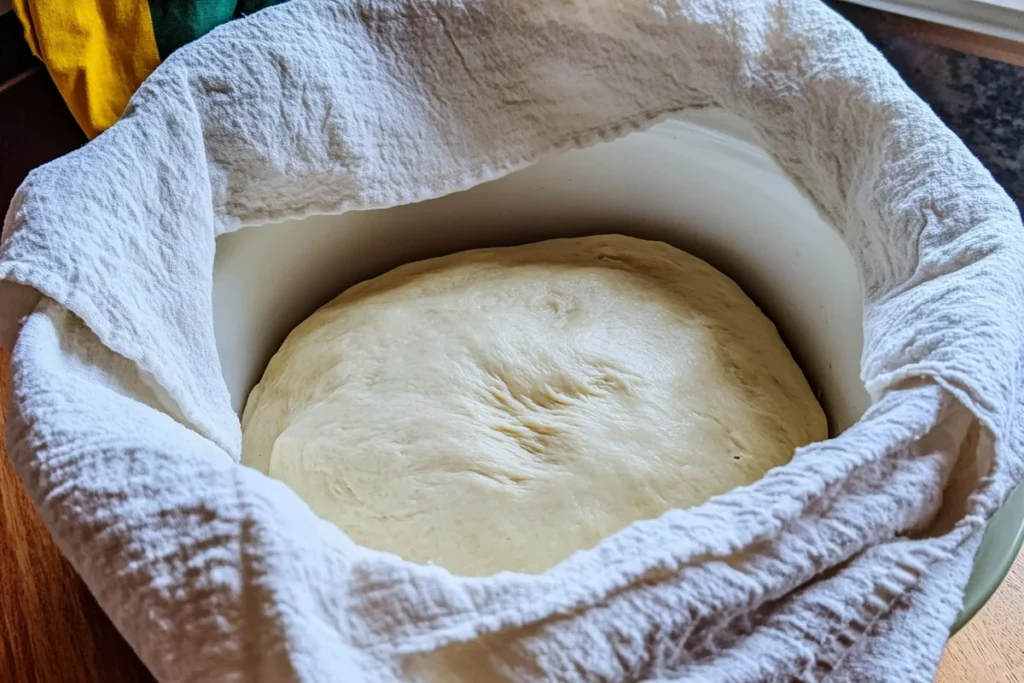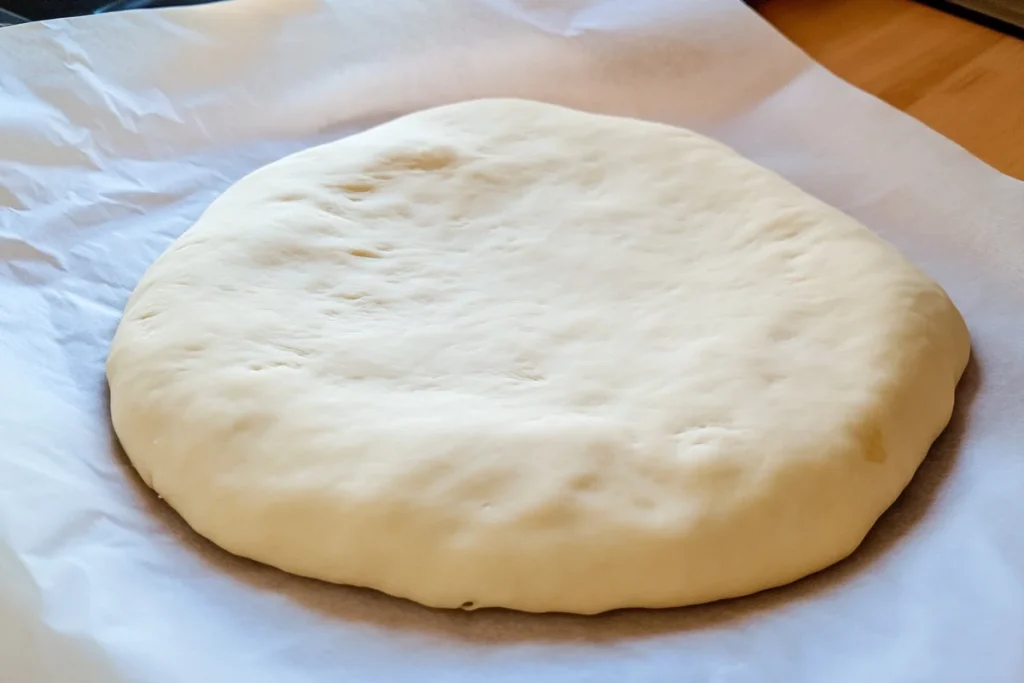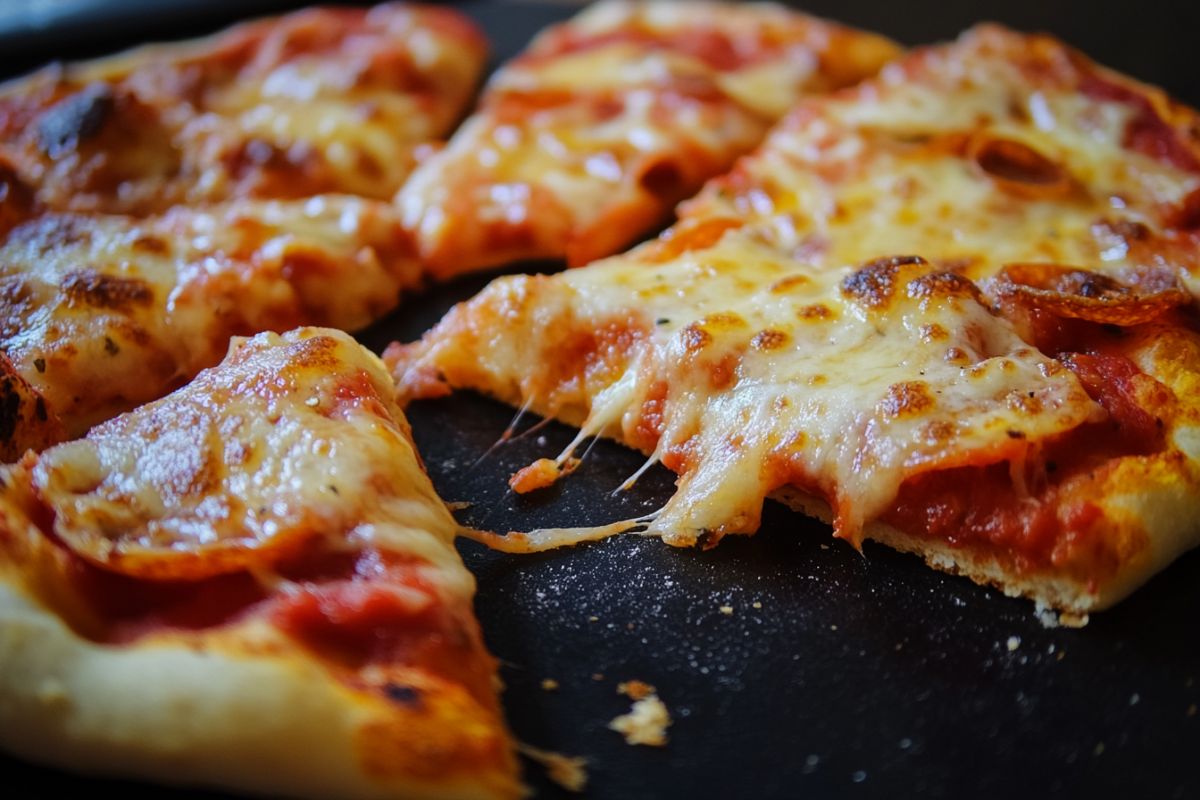Sourdough discard pizza dough is a fantastic way to use up that extra starter that often ends up down the drain. It adds a wonderful tangy flavor to your homemade pizza crust. Plus, it’s a great way to reduce food waste! This recipe is simple enough for a busy weeknight, yet yields delicious results.
Making sourdough discard pizza dough is a fun and rewarding experience. It’s all about transforming something you might normally discard into a delicious family meal. The dough develops a lovely, chewy texture and a unique sourdough flavor that everyone will love. If you enjoy baking with sourdough, you might also like this German Buns recipe.
My mom always taught me the value of using every ingredient, and this recipe is a perfect example of that. It’s a real win-win: a happy family and a happy sourdough starter! You can customize your pizza with your favorite toppings, making it a versatile meal option. This recipe will guide you through each step, from mixing to baking, for a perfect sourdough discard pizza.
Why this Sourdough Discard Pizza Dough is Special
This sourdough discard pizza dough recipe is special because it’s incredibly easy to follow. Even beginners can make it! You can adapt the recipe to your family’s preferences using various toppings. Whether you love a classic Margherita or a loaded meat-lovers pizza, this dough is the perfect base. And of course, using discard makes it extra special! You’re preventing food waste and creating something delicious.
Ingredients
This sourdough discard pizza dough comes together with just a few simple ingredients, most of which you probably already have in your pantry! Looking for other ways to utilize your discard? Check out this mayonnaise biscuit recipe.
For the Dough
- 1 cup (225g) sourdough starter discard: This is the star of the show! Use your unfed sourdough starter discard straight from the refrigerator. Its tangy flavor adds depth to the crust.
- 1 cup (240ml) warm water: The water activates the yeast and helps combine the ingredients. Make sure it’s lukewarm, not hot.
- 2 tablespoons (30ml) olive oil: Olive oil contributes to the flavor and texture of the crust, making it more pliable and giving it a nice golden color.
- 1 teaspoon (5g) salt: Salt enhances the flavors of the dough and controls the yeast activity.
- 3 cups (375g) bread flour: Bread flour has a higher protein content than all-purpose flour, which results in a chewier crust. You can use all-purpose flour if that’s what you have. Just know the texture may be slightly different.
- ½ cup (60g) all-purpose flour (or more, as needed): We’ll use this for dusting and adjusting the dough consistency.
For the Pizza Toppings (Optional – provide suggestions)
The topping possibilities are endless! Here are a few ideas:
- Classic Margherita: Simple and delicious with tomato sauce, fresh mozzarella, and basil.
- Pepperoni Pizza: A crowd-pleaser with pepperoni slices and your favorite cheese blend.
- Vegetarian Delight: Load it up with your favorite veggies like mushrooms, onions, peppers, and olives.
Instructions
Let’s get our hands into some dough! These step-by-step instructions will guide you through making the perfect sourdough discard pizza dough. For a delicious pasta dish, try this Asparagus Lemon Pasta.
Mixing the Dough
In a large bowl, combine the sourdough discard and warm water. Stir until the discard is mostly dissolved. Add the olive oil and salt, and mix well.
Next, add the bread flour, one cup at a time, mixing with a wooden spoon or a spatula until a shaggy dough forms. If you’re using a stand mixer, use the dough hook attachment and mix on low speed.
Turn the dough out onto a lightly floured surface. Knead for 5-7 minutes, adding more all-purpose flour as needed, until the dough is smooth and slightly tacky, but not sticky. If using a stand mixer, knead for about 5 minutes on medium-low speed. The dough should be pulling away from the sides of the bowl.
Bulk Fermentation
Lightly grease a large bowl with olive oil. Place the dough in the bowl, turning to coat it with the oil. Cover the bowl with plastic wrap or a damp kitchen towel.

Now comes the bulk fermentation. This is where the magic happens! The yeast in the sourdough discard will start to work, producing gas and making the dough rise. Let the dough ferment at room temperature (ideally around 75-80°F) for 4-6 hours, or until it has almost doubled in size. The time may vary depending on the temperature and the activity of your discard. For more information on the benefits of fermentation, check out this article on fermented foods.
Shaping the Dough
Once the dough has fermented, gently punch it down to release the air. Divide the dough in half (or into smaller portions for individual pizzas). Lightly flour your work surface and gently shape each portion into a round or rectangular crust.
For a round pizza, use your hands to stretch the dough from the center outwards, rotating it as you go. Avoid using a rolling pin, as it can compress the air bubbles and make the crust dense. For a rectangular pizza, use your fingers to gently stretch and shape the dough into the desired dimensions.
Aim for a crust thickness of about ¼ inch to ½ inch, depending on your preference. If you want a thicker crust, let the shaped dough rest for another 15-20 minutes before adding toppings. This allows the gluten to relax, making it easier to stretch further without tearing. If you’re interested in learning more about gluten, this article is a great resource.

Adding Toppings
Preheat your oven to 450°F (232°C). If using a pizza stone or baking steel, preheat it in the oven as well. This will help create a crispy crust.
Place the shaped dough on a piece of parchment paper or a lightly floured pizza peel. Spread a thin layer of your favorite pizza sauce over the dough, leaving about ½ inch of border for the crust. Don’t overload the sauce, or the crust will become soggy.
Sprinkle your favorite cheese over the sauce, followed by your desired toppings. Get creative! Remember, less is more with toppings, especially if you want a crisp crust. Too many toppings can weigh down the pizza and prevent it from cooking evenly. For some topping inspiration, check out this delicious Marry Me Chicken Pasta recipe.
Baking and Serving
Now for the grand finale – baking and enjoying your delicious sourdough discard pizza!
Baking the Pizza
Carefully slide the pizza (with the parchment paper) onto the preheated pizza stone or baking steel. If you don’t have either of those, you can bake it directly on a baking sheet.
Bake for 12-15 minutes in a conventional oven, or 10-12 minutes in a convection oven. If using a pizza stone or baking steel, the baking time may be slightly shorter, so keep a close eye on it.
The pizza is done when the crust is golden brown and the cheese is melted and bubbly. You might even see some charring on the edges of the crust, which adds a nice smoky flavor.
Serving Suggestions
Freshly baked pizza is best served immediately! Slice it into wedges and enjoy. This Strawberry Smoothie Recipe would make a refreshing accompaniment to your pizza.

Sourdough discard pizza pairs wonderfully with a simple green salad dressed with a light vinaigrette. You can also serve it with some appetizers like garlic knots, breadsticks, or a Caprese salad. For beverages, consider pairing it with Italian soda, iced tea, or a light-bodied red wine like a Chianti. My kids love it with a glass of cold milk!
This pizza is perfect for a casual weeknight dinner, a weekend gathering with friends, or even a fun pizza party. Everyone loves homemade pizza!
Cooling and Storage
If you have any leftovers (which is rare in my house!), let the pizza cool completely before storing it. Wrap it tightly in plastic wrap or aluminum foil, or place it in an airtight container. Store it in the refrigerator for up to 3 days.
To reheat, you can place a slice in a toaster oven or a regular oven preheated to 350°F (175°C) for a few minutes, or until heated through. You can also reheat it in a skillet over medium heat, which will help crisp up the crust.
Frequently Asked Questions
Here are some answers to commonly asked questions about sourdough discard and pizza dough:
Can you use just sourdough discard for pizza dough?
Yes, absolutely! This recipe is designed to use primarily sourdough discard. While a small amount of active, bubbly starter can enhance the rise and give a slightly more pronounced sourdough flavor, it’s not essential. The discard itself provides a unique tangy flavor and contributes to a wonderfully chewy texture in the pizza crust. This is a great way to utilize your discard and avoid food waste.
Is sourdough good for pizza dough?
Sourdough is fantastic for pizza dough! It adds a complexity and depth of flavor you just can’t get with regular yeast. The sourdough fermentation process creates a light and airy crust with a satisfying chew. It also has the added benefit of extending the shelf life of your dough and making it more digestible. My husband particularly loves the flavor sourdough brings to pizza crust.
What happens if you bake sourdough discard?
Baking sourdough discard is a great way to use it up! Don’t let it go to waste. The baking process mellows out the sourness while still retaining a pleasant tangy flavor. It adds a unique character to baked goods like crackers, pancakes, and of course, this delicious pizza crust. For another great sourdough discard recipe, try these german buns.
How long should sourdough pizza dough ferment?
The fermentation time for sourdough discard pizza dough can vary depending on the room temperature and the activity of your discard. This recipe recommends a bulk fermentation period of 4-6 hours at 75-80°F. However, if your kitchen is cooler, it might take longer. Just keep an eye on the dough and let it rise until almost doubled.
Can you eat straight sourdough discard?
Technically, you can eat sourdough discard straight from the jar, but it’s not very enjoyable. It’s quite sour and not particularly palatable on its own. It’s much better when incorporated into recipes like this pizza dough!
What is in King Arthur pizza dough flavor?
King Arthur pizza dough flavor is a commercial blend of dried herbs and spices, typically including oregano, basil, garlic powder, and onion powder. While convenient, this recipe encourages using fresh herbs for a brighter, more vibrant flavor in your pizza.
Tips and Variations
Here are a few tips and variations to help you make the best sourdough discard pizza:
- Dough too sticky? If your dough is too sticky, add more all-purpose flour, a tablespoon at a time, until it becomes manageable. Don’t be afraid to get your hands in there!
- Dough too dry? If your dough feels too dry, add a teaspoon of warm water at a time until it comes together. Humidity can play a role in dough consistency.
- Experiment with flours: Try using whole wheat flour or rye flour for a nuttier flavor and a denser crust. My daughter loves when I use whole wheat flour! For a simple treat, consider making this pound cake recipe.
- Get creative with toppings: The sky’s the limit! Use whatever toppings your family enjoys. We love having a “pizza night” where everyone gets to choose their own toppings. It’s a fun family activity.
- Make it a party: Pizza making is a great activity to do with kids. Let them help with measuring, mixing, and adding toppings. My son always insists on adding the pepperoni! It’s messy but worth the memories.
- Cold ferment: For a deeper flavor, you can let the dough cold ferment in the refrigerator for up to 24 hours after the bulk fermentation. This slows down the fermentation process and develops more complex flavors. Just take it out of the fridge an hour or two before shaping.
- Spice it up: Add a pinch of red pepper flakes to the dough for a little heat.
Making pizza together is one of our favorite family traditions. It’s a simple way to connect and create lasting memories in the kitchen. I hope this recipe brings as much joy to your family as it does to mine!
Conclusion
Making sourdough discard pizza dough is such a rewarding experience! It’s a delicious way to reduce food waste and enjoy the amazing flavor that sourdough brings to pizza. From the tangy, chewy crust to the endless topping possibilities, this recipe is a keeper. I encourage you to give it a try and experience the joy of transforming your sourdough discard into a fantastic family meal. I’m sure it will become a regular in your kitchen, just like it is in mine. Don’t forget to share your pizza creations and let me know how it turns out! Happy baking!

